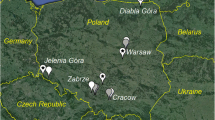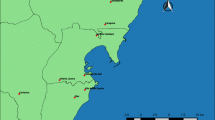Abstract
This study aims to apply principal component analysis (PCA) to identify monitoring sites with similar variations of PM10 concentrations in the London Air Quality Monitoring Network. This statistical methodology was applied to hourly average concentrations measured at 27 monitoring sites during the period from January 2000 to December 2009. The monitoring sites were selected according their efficiency in the study period (greater than 75% for each year). It was observed that the hourly average PM10 concentrations were decreasing along the selected period at almost all monitoring sites. PCA was performed for each year, selecting the number of principal components (PCs) that had at least 95% of the original data variance. Analysing the frequency with which each pair of monitoring sites gave a significant contribution to the same PC, nine city areas with specific PM10 behaviour were identified. Thus, monitoring sites with redundant measurements during the studied period were identified, being possible to remove them to decrease the costs relative to their maintenance or replace them to increase the monitored area.




Similar content being viewed by others
References
Afif, C., Dutot, A. L., Jambert, C., Abboud, M., Adjizian-Gérard, J., Farah, W., Perros, P. E., & Rizk, T. (2009). Statistical approach for the characterization of NO2 concentrations in Beirut. Air Quality, Atmosphere & Health, 2, 57–67.
Atkinson, R. W., Barratt, B., Armstrong, B., Anderson, H. R., Beevers, S. D., Mudway, I. S., Green, D., Derwent, R. G., Wilkinson, P., Tonne, C., & Kelly, F. J. (2009). The impact of the congestion charging scheme on ambient air pollution concentrations in London. Atmospheric Environment, 43, 5493–5500.
Beevers, S. D., & Carslaw, D. C. (2005). The impact of congestion charging on vehicle emissions in London. Atmospheric Environment, 39, 1–5.
Brunekreef, B., & Holgate, S. T. (2002). Air pollution and health. Lancet, 360, 1233–1242.
Directive: 2008, ‘Council Directive 2008/50/EC, on ambient air quality and cleaner air for Europe’, Official Journal of the European Communities L151, 1–44.
Dockery, D. W., & Pope, C. A. (1994). Acute respiratory effects of particulate air-pollution. Annual Review of Public Health, 15, 107–132.
Fuller, G. W., & Green, D. (2004). The impact of local fugitive PM10 from building works and road works on the assessment of the European Union Limit Value. Atmospheric Environment, 38, 4993–5002.
Fuller, G. W., & Green, D. (2006). Evidence for increasing concentrations of primary PM10 in London. Atmospheric Environment, 40, 6134–6145.
Fuller, G., & Meston, L., (2008). London Air Quality Network Report 13, London.
Fuller, G. W., Carslaw, D. C., & Lodge, H. W. (2002). An empirical approach for the prediction of daily mean PM10 concentrations. Atmospheric Environment, 36, 1431–1441.
Gao, T., Xie, S.-D., Bo, Y., & Zhao, Y. (2010). Assessing PM10 and SO2 networks using positive matrix factorization in Beijing City. Huanjing Kexue/Environmental Science, 31, 560–565.
GLA, GLA. (2010). Clearing the air-The Mayor’s Air Quality Strategy. London: Greater London Authority.
Gramsch, E., Cereceda-Balic, F., Oyola, P., & von Baer, D. (2006). Examination of pollution trends in Santiago de Chile with cluster analysis of PM10 and Ozone data. Atmospheric Environment, 40, 5464–5475.
Green, D., & Fuller, G. W. (2006). The implications of tapered element oscillating microbalance (TEOM) software configuration on particulate matter measurements in the UK and Europe. Atmospheric Environment, 40, 5608–5616.
Green, D. C., Fuller, G. W., & Baker, T. (2009). Development and validation of the volatile correction model for PM10—An empirical method for adjusting TEOM measurements for their loss of volatile particulate matter. Atmospheric Environment, 43, 2132–2141.
Hoek, G., Brunekreef, B., Goldbohm, S., Fischer, P., & van den Brandt, P. A. (2002). Association between mortality and indicators of traffic-related air pollution in the Netherlands: a cohort study. Lancet, 360, 1203–1209.
Ibarra-Berastegi, G., Saenz, J., Ezcurra, A., Ganzedo, U., de Argandona, J. D., Errasti, I., Fernandez-Ferrero, A., & Polanco-Martinez, J. (2009). Assessing spatial variability of SO2 field as detected by an air quality network using self-organizing maps, cluster, and principal component analysis. Atmospheric Environment, 43, 3829–3836.
Kannel, P. R., Lee, S., Kanel, S. R., & Khan, S. P. (2007). Chemometric application in classification and assessment of monitoring locations of an urban river system. Analytica Chimica Acta, 582, 390–399.
Kappos, A. D., Bruckmann, P., Eikmann, T., Englert, N., Heinrich, U., Hoppe, P., Koch, E., Krause, G. H. M., Kreyling, W. G., Rauchfuss, K., Rombout, P., Schulz-Klemp, V., Thiel, W. R., & Wichmann, H. E. (2004). Health effects of particles in ambient air. International Journal of Hygiene and Environmental Health, 207, 399–407.
Koelemeijer, R. B. A., Homan, C. D., & Matthijsen, J. (2006). Comparison of spatial and temporal variations of aerosol optical thickness and particulate matter over Europe. Atmospheric Environment, 40, 5304–5315.
Kukkonen, J., Pohjola, M., Sokhi, R. S., Luhana, L., Kitwiroon, N., Fragkou, L., Rantamaki, M., Berge, E., Odegaard, V., Slordal, L. H., Denby, B., & Finardi, S. (2005). Analysis and evaluation of selected local-scale PM10 air pollution episodes in four European cities: Helsinki, London, Milan and Oslo. Atmospheric Environment, 39, 2759–2773.
LAQN: 2010, London Air Quality Network, in K. s. C. Environmental Research Group (Ed.) London.
Lau, J., Hung, W. T., & Cheung, C. S. (2009). Interpretation of air quality in relation to monitoring station’s surroundings. Atmospheric Environment, 43, 769–777.
Lu, W. Z., He, H. D., & Dong, L. Y. (2011). Performance assessment of air quality monitoring networks using principal component analysis and cluster analysis. Building and Environment, 46, 577–583.
Mendiguchia, C., Moreno, C., Galindo-Riano, M. D., & Garcia-Vargas, M. (2004). Using chemometric tools to assess anthropogenic effects in river water—a case study: Guadalquivir River (Spain). Analytica Chimica Acta, 515, 143–149.
Pires, J. C. M., Sousa, S. I. V., Pereira, M. C., Alvim-Ferraz, M. C. M., & Martins, F. G. (2008a). Management of air quality monitoring using principal component and cluster analysis—part I: SO2 and PM10. Atmospheric Environment, 42, 1249–1260.
Pires, J. C. M., Sousa, S. I. V., Pereira, M. C., Alvim-Ferraz, M. C. M., & Martins, F. G. (2008b). Management of air quality monitoring using principal component and cluster analysis—part II: CO, NO2 and O-3. Atmospheric Environment, 42, 1261–1274.
Pires, J. C. M., Martins, F. G., Alvim-Ferraz, M. C. M., & Pereira, M. C. (2009a). Evaluation of redundant measurements on the air quality monitoring network of Lisbon and Tagus Valley. Chemical Product and Process Modeling, 4, 1–10.
Pires, J. C. M., Pereira, M. C., Alvim-Ferraz, M. C. M., & Martins, F. G. (2009b). Identification of redundant air quality measurements through the use of principal component analysis. Atmospheric Environment, 43, 3837–3842.
Rhys-Tyler, G. A., Legassick, W., & Bell, M. C. (2011). The significance of vehicle emissions standards for levels of exhaust pollution from light vehicles in an urban area. Atmospheric Environment, 45, 3286–3293.
Shrestha, S., & Kazama, F. (2007). Assessment of surface water quality using multivariate statistical techniques: a case study of the Fuji river basin, Japan. Environment Modelling Software, 22, 464–475.
Singh, K. P., Malik, A., Mohan, D., & Sinha, S. (2004). Multivariate statistical techniques for the evaluation of spatial and temporal variations in water quality of Gomti River (India)—a case study. Water Research, 38, 3980–3992.
Wenger, D., Gerecke, A. C., Heeb, N. V., Hueglin, C., Seiler, C., Haag, R., Naegeli, H., & Zenobi, R. (2009). Aryl hydrocarbon receptor-mediated activity of atmospheric particulate matter from an urban and a rural site in Switzerland. Atmospheric Environment, 43, 3556–3562.
Wilson, J. G., Kingham, S., Pearce, J., & Sturman, A. P. (2005). A review of intraurban variations in particulate air pollution: implications for epidemiological research. Atmospheric Environment, 39, 6444–6462.
Wold, S., Esbensen, K., & Geladi, P. (1987). Principal component analysis. Chemometrics Intelligence Laboratory, 2, 37–52.
Yu, T. Y., & Chang, L. F. W. (2000). Selection of the scenarios of ozone pollution at southern Taiwan area utilizing principal component analysis. Atmospheric Environment, 34, 4499–4509.
Acknowledgements
The authors thank the Environmental Research Group at King’s College London that manages the London Air Quality Monitoring Network. J.C.M. Pires thanks the Foundation for Science and Technology for the fellowship SFRH/BPD/66721/2009.
Author information
Authors and Affiliations
Corresponding author
Rights and permissions
About this article
Cite this article
Pires, J.C.M., Martins, F.G. Evaluation of Spatial Variability of PM10 Concentrations in London. Water Air Soil Pollut 223, 2287–2296 (2012). https://doi.org/10.1007/s11270-011-1023-2
Received:
Accepted:
Published:
Issue Date:
DOI: https://doi.org/10.1007/s11270-011-1023-2




